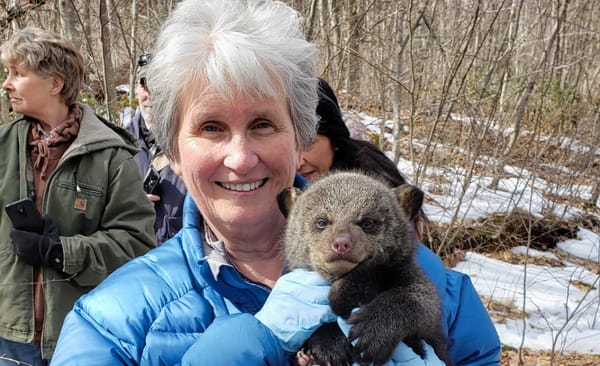The Rural We: Ginny Apple
The Connecticut master wildlife conservationist is dedicated to teaching us about the environment and protecting animals.

The Connecticut master wildlife conservationist is dedicated to teaching us about the environment and protecting animals.

A master wildlife conservationist for the Connecticut Department of Energy and Environmental Protection (DEEP), Ginny Apple was scheduled to give a talk at the David M. Hunt Library in Falls Village on March 21. The topic was to be the recovery of bald eagles as a species in the state, but a look at her bio made us curious to know more about her and what she does. A native Texan, Apple was one of the first full-time women sportswriter in the country. She worked for the LA Times and Hartford Courant, among other newspapers, but got tired of the night, holiday and weekend demands of a sportswriter. She then went into PR, and worked for the Connecticut judicial branch before “retiring” to Barkhamsted, Conn.
I moved here, close to the west branch of the Farmington River, because I saw a place surrounded by Peoples State Forest. My house is the oldest house in town, built in 1760. It’s supposedly haunted. I haven’t seen the ghost, but people who have stayed here say they have. The property gives me good access to the local ponds and rivers. I kayak and canoe a lot. I’ve hiked all the four-thousand footers in New England and the Adirondacks, and I still hike extensively in this area.
I grew up on a ranch in Texas, so I’ve always been around animals. I became a master wildlife conservationist before retiring. The DEEP gives trainings every other year to get volunteers for educational purposes. When I speak to the public, I try to give the historical background of a species, and to get people to realize that the most important thing for us and our children and the animals is the environment. I stress how we need to keep the environment safe and healthy, and respect the animals and their boundaries.
Wildlife in Massachusetts, Connecticut and Rhode Island is challenged by humans. It’s the humans who will not learn to coexist. A lot of our animals are now exurban, which means they can tolerate a certain amount of urbanization. Even the eagles have become more tolerant. Connecticut had only one pair of nesting eagles in 1992, and by last year we had 64 pairs. That’s a phenomenal recovery, in part because we’ve banned DDT, have put in environmental protections and cleaned the waterways, which means the fish, a food source for eagles, are cleaner.
Unfortunately, wind turbines are killing millions of birds and bats. Regarding bears, we have a population of under 900 in Connecticut, and almost 60 of them are killed by cars each year. For bald eagles, the biggest threats are lead poisoning. It comes from the lead shot hunters use. Although Connecticut has banned lead lures, there’s no telling how much lead shot some hunters have stored up and are still using.
The funniest thing happened today. I watched a porcupine and a bear have a standoff. A female with her yearling were in my yard sniffing around, and kept looking out to one direction. I couldn’t see anything, and wondered what was getting their attention. The little bear shot up the tree, and the sow (mama bear) leaned against it. A porcupine came across the yard, getting closer and closer to the sow. The sow moved about a yard towards the porcupine, and the porcupine turned around and ran away. It’s a delight to live here and see these things. It’s still magical for me every time I see the animals.